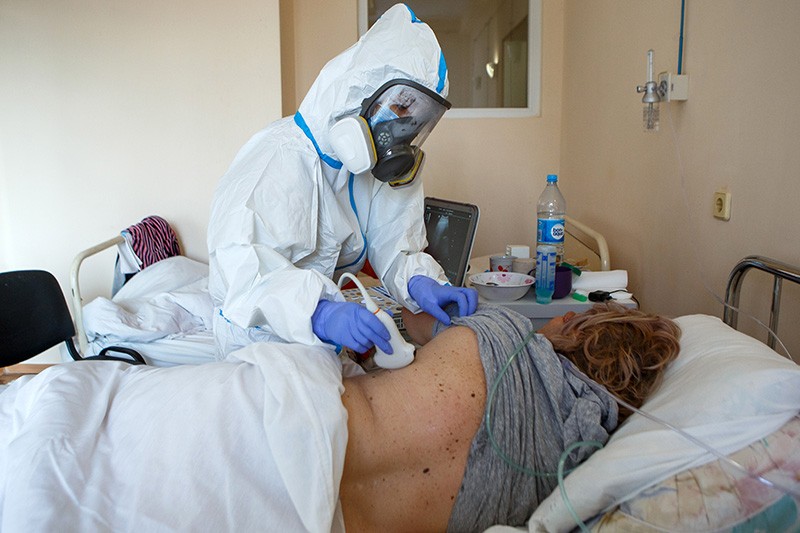

a physician in Uzhhorod, Ukraine, examines the lungs of an individual with COVID-19. The Omicron variant might affect the lungs lower than do up to now circulating versions.credit score: Serhii Hudak/Ukrinform/Barcroft Media by way of Getty
Early indications from South Africa and the UK signal that the fast-spreading Omicron variant of the coronavirus SARS-CoV-2 is much less dangerous than its predecessor Delta. Now, a collection of laboratory stories offers a tantalizing reason behind the change: Omicron does not infect cells deep within the lung as easily as it does those in the upper airways.
"It's a really captivating remark that could explain what we see in patients," says Melanie Ott, a virologist on the Gladstone Institute of Virology in San Francisco, California, who turned into not concerned within the analysis. but she adds that Omicron's hyper-transmissibility potential that hospitals are filling straight away — regardless of any reduce in the severity of the disorder it reasons.
Authorities in South Africa introduced on 30 December that the country had passed its Omicron top without a tremendous spike in deaths. And a 31 December UK executive record pointed out that people in England who had been infected with Omicron were about half as likely to require hospitalization or emergency care as have been those infected with Delta.
however the number of americans who've gained immune protection towards COVID-19 via vaccination, infection or both has grown over time, making it problematic to determine even if Omicron intrinsically reasons milder sickness than prior variants. For solutions, researchers have turned to animals and to cells in laboratory dishes.
Michael Diamond, a virologist at Washington university in St. Louis, Missouri, and his colleagues infected hamsters and mice with Omicron and different variations to tune disorder progression. The alterations were striking: after a few days, the concentration of virus in the lungs of animals infected with Omicron changed into at least ten times lessen than that in rodents contaminated with different variants1. other teams have additionally referred to that compared with outdated variants, Omicron is discovered at reduced degrees in lung tissue2,3.
Diamond says he was especially stunned to peer that the Omicron-infected animals nearly maintained their body weight, whereas the others promptly misplaced weight — a sign that their infections had been causing extreme ailment. "every strain of SARS-CoV-2 has infected hamsters very easily, to excessive degrees," he says, "and it's clear that this one is distinctive for hamsters." The lungs are the place the coronavirus does plenty of its damage, and lung an infection can set off an inflammatory immune response that ravages infected and uninfected cells alike, leading to tissue scarring and oxygen deprivation. Fewer contaminated lung cells might mean milder disease.
yet another neighborhood found that Omicron is a whole lot less a success than old variations at infecting lung cells and miniature lung models called organoids4. These experiments additionally identified a plausible participant in the change: a protein called TMPRSS2, which protrudes from the surfaces of many cells in the lungs and different organs, but is mainly absent from the surfaces of most nose and throat cells.
old versions have exploited this protein to contaminate cells, however the researchers observed that Omicron doesn't bind to TMPRSS2 so smartly. in its place, it prefers to enter cells through fusing without delay with their membranes, a discovering reproduced by other teams5,6.
difficulty coming into lung cells might support to explain why Omicron does stronger in the higher airways than in the lungs, says Ravindra Gupta, a virologist at the university of Cambridge, UK, who co-authored probably the most TMPRSS2 studies4. This conception may additionally clarify why, by some estimates, Omicron is virtually as transmissible as measles, which is the benchmark for high transmissibility, says Diamond. If the variant lingers within the upper airways, viral particles may find it convenient to affix a trip on cloth expelled from the nostril and mouth, allowing the virus to discover new hosts, says Gupta. other facts give direct facts that Omicron replicates greater easily in the upper airways than in the lungs2,5.
The newest outcomes could imply that "the virus establishes a extremely native infection within the upper airways and has less probability to go and wreak havoc within the lungs", Ott says. that could be welcome news — but a bunch's immune response plays a vital half in disorder severity, and scientists want extra clinical statistics if they are to be aware how Omicron's fundamental biology influences its disorder progression in humans.
Omicron's route of an infection might also have implications for little ones, says Audrey John, a specialist in paediatric infectious disease at the children's clinic of Philadelphia in Pennsylvania. young toddlers have notably small nasal passages, and little ones breathe simplest through their noses. Such factors can make upper respiratory situations greater severe for toddlers than for adults, John says. however she adds that she has now not seen statistics suggesting an uptick in the numbers of younger toddlers hospitalized for croup and different situations that may point out a severe an infection of the higher respiratory tract.
however there remains lots to be trained about the new variant, Gupta says that fears raised in late November by using the multitude of mutations in Omicron's genome have not been fully borne out. He says the initial alarm offers a cautionary tale: it's complicated to predict how a plague will infect organisms from its genetic sequence alone.

Post a Comment